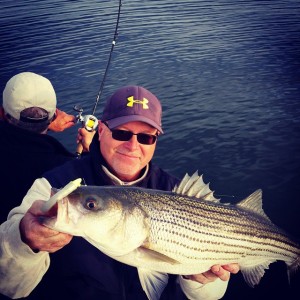chesapeake bay
1. When your wife or girlfriend asks, “You aren’t going to fish in the rain are you?”
Well, yes I am, and in the sleet, and in the snow, and in the fog, and any other time the other guys are at home sitting on the couch.
2. Or when she wonders, “Why do you need another fishing rod, you already have three?”
And that puts me in the lower five percent of all the other fishermen I know who each have at least sixty.
3. Or how about, “Will you be home by dark?”
No, I’ll fish until dark, and if the fish are biting I’ll keep fishing until they stop or at least until my muscles become so stiff they have to pry my rod out of my cold wet fingers.
4. And, I hope you haven’t heard, “My old boyfriend caught one bigger than that.”
I don’t care. Okay, I do care, but I don’t want to hear about it! And that reminds me, don’t say:
5. “Cute little guy.”
Not about a fish, not about anything, not ever! Read More!
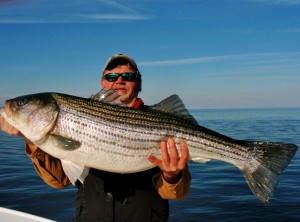 I may have found the best fishing spot in the Chesapeake Bay. I discovered it completely by accident a few years ago. I was zig-zagging across some ledges in the Mid-Bay when I saw something on my fish finder that looked like a miniature underwater forest. My first thought was that I was seeing small tree trunks or the remains of fence posts coming up from the bottom. Then I thought maybe I was seeing a shipwreck, but the more I explored the area, the more it became apparent that my sonar was pinging over more natural structure. I was seeing the sonar returns of oysters, and lots of them.
I may have found the best fishing spot in the Chesapeake Bay. I discovered it completely by accident a few years ago. I was zig-zagging across some ledges in the Mid-Bay when I saw something on my fish finder that looked like a miniature underwater forest. My first thought was that I was seeing small tree trunks or the remains of fence posts coming up from the bottom. Then I thought maybe I was seeing a shipwreck, but the more I explored the area, the more it became apparent that my sonar was pinging over more natural structure. I was seeing the sonar returns of oysters, and lots of them.
When oysters are left to grow, they form highly complex and irregular reefs. This is a result of the natural reproduction process by which larvae is set onto existing shells. These new shells clump together with older ones, and grow upward toward the surface. When the reefs go unharvested, they grow into mounds or plumes. When they’re left alone for a long time, the mounds can reach the surface of the water and be visible at low tides. In regions where oysters are plentiful, they call these mounds “oyster rocks.” That’s a term you don’t hear too much in Maryland because there aren’t any oyster rocks left. Read More!
Have you seen this yet? Lenny Rudow asked me to join him and his sons David and Max as they filmed an episode for his internet-based fishing show, Got Bait?. Sponsored by Boats.com, the series is professionally filmed and produced by Paul Cronin Productions. I was pumped about the invitation for several reasons, not the least of which is that I would get to fish with 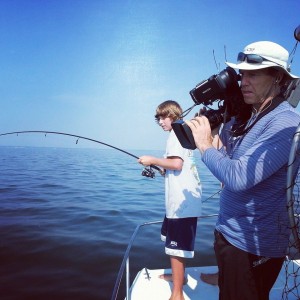 Lenny. He and I move around in similar circles, but we’ve only had one brief opportunity to fish together. I’m a big fan of Lenny’s informative How-To books about fishing the Chesapeake Bay, especially his iconic and aptly titled Rudow’s Guide To Fishing The Chesapeake. Additionally, I’ve heard great things about Max and David, so this would be my opportunity to finally meet them. To make the invitation even better, my friend Gary Reich would be joining us as assistant producer.
Lenny. He and I move around in similar circles, but we’ve only had one brief opportunity to fish together. I’m a big fan of Lenny’s informative How-To books about fishing the Chesapeake Bay, especially his iconic and aptly titled Rudow’s Guide To Fishing The Chesapeake. Additionally, I’ve heard great things about Max and David, so this would be my opportunity to finally meet them. To make the invitation even better, my friend Gary Reich would be joining us as assistant producer.
On the morning of the filming, I launched my 27′ Judge Center Console Thunder Road at Matapeake and zoomed by Thomas Point Light to our predetermined rendezvous point outside the West River. The plan was to use my boat as the chase boat for filming, and Lenny’s PowerCat for fishing. As I jumped on board with Lenny and handed the boat keys over to Gary, I pointed out that the weather was great and all signs pointed toward a successful fishing day. That might have been what jinxed us. Read More!
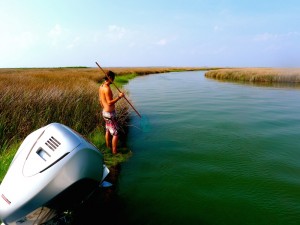 I hang with a lot of fisheries guys. If I had to guess at the backgrounds of the people I’ve fished with most frequently, it would be (in order) coaching baseball, cutting meat, and studying fish. My brother is a fisheries biologist as are many of my friends. I was thrilled recently when a young fisherman who is still in high school reached out to me about his career plans, “I want to be a fish scientist,” he said. “I want to make a difference.” Obviously, I appreciate those guys and the science in which they work.
I hang with a lot of fisheries guys. If I had to guess at the backgrounds of the people I’ve fished with most frequently, it would be (in order) coaching baseball, cutting meat, and studying fish. My brother is a fisheries biologist as are many of my friends. I was thrilled recently when a young fisherman who is still in high school reached out to me about his career plans, “I want to be a fish scientist,” he said. “I want to make a difference.” Obviously, I appreciate those guys and the science in which they work.
I looked up the term Fisheries Management and found this: Fisheries management draws on fisheries science in order to find ways to protect fishery resources.
I like the phrase, “draws on fisheries science.” As a fisherman and a conservationist, I want management decisions based on facts, not politics, pseudoscience, or hearsay. I am a student of the collective knowledge acquired by fishermen. There’s nothing I’d rather hear than the recommendations of a seasoned angler or the sage advice of an experienced waterman. On the other hand, I work in a scientific profession, so I recognize that good science trumps folklore on every occasion. Read More!
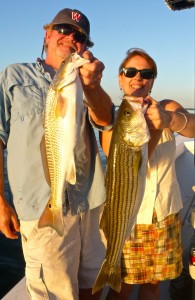 When I started dating my wife, I spent a considerable amount of time driving back and forth on Interstate 81 between Knoxville, Tennessee and Washington, DC. If you’ve ever driven that stretch of highway, you know that it can be miserable at times due to heavy traffic. I didn’t have to sit through very many traffic jams before I figured out some alternate routes. Highway 11, also known as Lee Highway, was the primary north-south artery along the west side of the Blue Ridge Mountains through the Shenandoah Valley long before the interstate was built. I soon realized that, even on the heaviest traffic days, it’s possible to jump off onto 11 and ride for jam-free miles through some of the most scenic country in the region. Before long, I started picking out segments of Lee Highway to drive along even when traffic wasn’t backed up on the interstate.
When I started dating my wife, I spent a considerable amount of time driving back and forth on Interstate 81 between Knoxville, Tennessee and Washington, DC. If you’ve ever driven that stretch of highway, you know that it can be miserable at times due to heavy traffic. I didn’t have to sit through very many traffic jams before I figured out some alternate routes. Highway 11, also known as Lee Highway, was the primary north-south artery along the west side of the Blue Ridge Mountains through the Shenandoah Valley long before the interstate was built. I soon realized that, even on the heaviest traffic days, it’s possible to jump off onto 11 and ride for jam-free miles through some of the most scenic country in the region. Before long, I started picking out segments of Lee Highway to drive along even when traffic wasn’t backed up on the interstate.
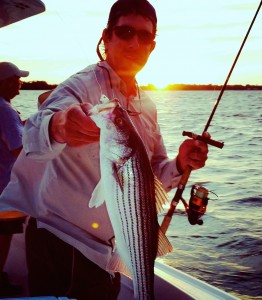 Since I have family and property in Tennessee, I continue to make that trip often and I still plan these panoramic diversions into my travel. Sometimes my ventures off the main road last only for an exit or two, but on some trips, I’ll drive for miles though the beautiful scenery and quaint communities of the Shenandoah. I look at these Lee Highway detours like they are mini-vacations from the usual hustle and bustle of the main thoroughfare. As a result, I’ve made some interesting discoveries. For example, did you know there is a full-size replica of Stonehenge made entirely out of styrofoam near Natural Bridge, Virginia, or that you can still get a delicious burger at the restaurant where Hank Williams ate his last meal in Bristol? Read More!
Since I have family and property in Tennessee, I continue to make that trip often and I still plan these panoramic diversions into my travel. Sometimes my ventures off the main road last only for an exit or two, but on some trips, I’ll drive for miles though the beautiful scenery and quaint communities of the Shenandoah. I look at these Lee Highway detours like they are mini-vacations from the usual hustle and bustle of the main thoroughfare. As a result, I’ve made some interesting discoveries. For example, did you know there is a full-size replica of Stonehenge made entirely out of styrofoam near Natural Bridge, Virginia, or that you can still get a delicious burger at the restaurant where Hank Williams ate his last meal in Bristol? Read More!
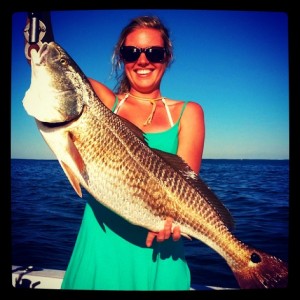 Bad news and more bad news. If you’re following the politics around striped bass management, you know it’s all bad news for the fish lately. Where are the rockfish in the Chesapeake Bay? It doesn’t take an expert to realize that almost every fishing boat from Solomons Island to Rock Hall is working one primary school of stripers. To quote conservation blogger John McMurray, “it’s not where the fish are, it’s where they aren’t,” and apparently they aren’t anywhere except near the mouth of Eastern Bay.
Bad news and more bad news. If you’re following the politics around striped bass management, you know it’s all bad news for the fish lately. Where are the rockfish in the Chesapeake Bay? It doesn’t take an expert to realize that almost every fishing boat from Solomons Island to Rock Hall is working one primary school of stripers. To quote conservation blogger John McMurray, “it’s not where the fish are, it’s where they aren’t,” and apparently they aren’t anywhere except near the mouth of Eastern Bay.
Despite the demise of our state fish, things are looking up for another native Chesapeake species, the red drum. You probably haven’t heard much about catching redfish in Maryland over the past decade, but that’s all changing. Last summer there were reports of redfish as far north as the Gunpowder River in the Upper Bay. I started targeting them around Kent Island last August, and I’m already catching them again this year.
Thanks to good management practices – especially by states to our south – and an overall warming trend along the Atlantic Coast, red drum are expanding their range. That’s good news for Chesapeake light tackle fishermen because redfish will readily attack a jig or a topwater plug. Even if you’ve never targeted redfish before, chances are you already know how to catch them. Almost all the artificial lure techniques we’re currently using for stripers will work for redfish. As stripers continue to decline, redfish are moving into their habitat and populating the underwater humps and ledges where stripers used to feed. Read More!



